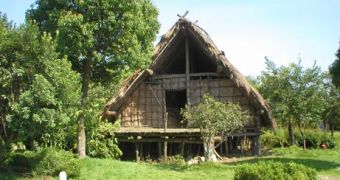Have you ever wondered why the Chinese represent 14 % of the planet's population? The secret is in the rice: by cultivating it, they could feed large populations during the Stone Age, overcoming easily in number the surrounding hunter-gatherer groups. Today, the diet of over 2 billion people worldwide is based on rice.
Rice allowed an earlier weaning of the children and women could get pregnant again more rapidly (lactation hormones prevent pregnancy). While for a nomad population of hunter-gatherers, having too many children at a time represented a problem, sedentary farmers did not face it. Larger families meant more paddy fields, provoking a population boom, while the hunter-gatherers lost territories. Farming communities could also support large armies.
Now, the oldest known paddy fields have been discovered in a Chinese coastal swamp and were estimated to be 7,700 years old. The team led by Cheng Zong of Britain's Durham University made some investigations at the site of Kuahuqiao in Zhejiang province near Hangzhou. Previous digs at this site revealed a Stone Age settlement of wooden houses perched on stilts over the swamps. The 8,000-year-old encountered issues included a dugout canoe, pottery which used wild rice as a bonding material, wood and bamboo tools and dog and pig bones.
Zong's team investigated if the sediments of the ancient swamp could betray rice cultivation. The soil appeared deliberately manipulated for cultivating rice: scrubs were cleared through fire, while flood-prevention actions impeded brackish water from entering the fields.
"The site provided us well-dated evidence for the earliest rice cultivation. Kuahuqiao supported rice farming until around 7,550 years ago, when rising sea levels suddenly deluged the area. Rice doesn't like saltwater," said Zong.
Sea levels were rising at the time due to global warming at the end of the Ice Age.
"We think [saltwater levels] must have been managed. Otherwise you would see a gradual rise in the brackish water influence. The water may have been held back by small earth dikes known as bunds," said Zong.
The soil also presented high amounts of animal and human dung.
"Whether the dung was deliberately used as fertilizer, or whether it was just washed naturally into the paddy fields, it's very difficult to be certain," Zong said.
But rice fragments from the swamp were of wild strains.
"The discovery of unusually large rice pollen grains, however, may signal the beginnings of domesticated varieties," Zong said.
Previous researches pointed that 6,000 years ago fully domesticated rice became present in China.
"Evolution of rice as a domesticated crop was a long, drawn-out process which may have taken millennia. The inhabitants of Kuahuqiao would have been forager-cultivators," said Dorian Fuller of University College London, who was involved in a such study. "Rice cultivation isn't the only thing they do, and it's possibly not the main thing they do. People who were using a wide range of other resources, including acorns and water chestnuts, started to manipulate marshland environments where rice was wild. The new study provides the earliest known evidence of rice paddies, though other, less solid evidence points to rice farming elsewhere in China around the same period. Wild rice grains from Stone Age sites along the middle Yangtze River have been dated to 6000 B.C. People were using rice earlier than this," added Fuller.
"Rice farming likely evolved independently in different parts of Asia, such as along the Ganges River in India. It's very clear now from the genetics of modern rice that it has multiple origins from the wild gene pool right across southern China and northern and eastern India," he explained.
"The study provides a fascinating interpretation that rice cultivation was taking place in slightly brackish coastal wetlands that were regularly flooded." said Gary Crawford, an anthropologist at the University of Toronto at Mississauga. The author believe that rice farming by the Kuahuqiao people was perhaps boosted by the warming clime, which set up proper conditions for cereal's cultivation.

 14 DAY TRIAL //
14 DAY TRIAL //